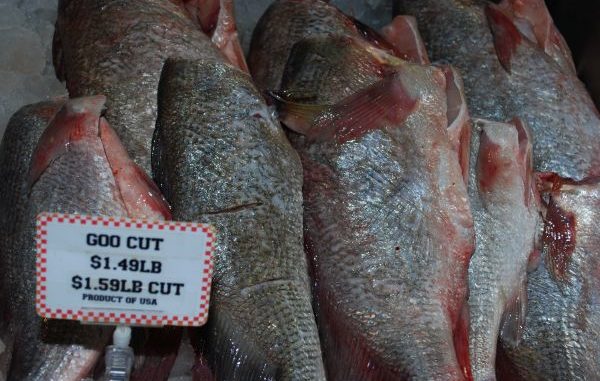
Lowly freshwater drum makes good table fare
The freshwater drum, Aplodinotus grunniens, has to be the most disrespected large freshwater fish in Louisiana and probably the whole United States.
Recreational fishermen fishing with tube jigs, spinners or any of a wide variety of natural baits will experience a hard strike and a decent fight.
But when the fish comes to the surface, the refrain is always the same, “Oh, it’s only a gou.”
The disdain anglers give the fish has nothing to do with its pedigree. It belongs to the drum family, easily the most important family of saltwater fishes along the Gulf Coast.
The family has 82 separate species in North America, including its Gulf and Atlantic stars — speckled trout and redfish. More species are found along the Atlantic coast than the Pacific, but only one species of the huge family lives out its entire life in freshwater, our humble gaspergou.
So far, I’ve used five names for the fish: goo, freshwater drum (the official common name), Aplodinotus grunniens (the scientific name), gou, and gaspergou.
But it has a lot more: bubbler, cambellite, croaker, drumfish, gray bass, grinder, grunt, grunter, lake sheepshead, perch, rock perch, sheepshead, shepherd’s pie, silver bass, thunderpumper, white perch and wuss fish.
As for the scientific name, the genus name Aplodinotus comes from Greek and means, of all things, “single back.” The species name, grunions is Latin and means, “grunting,” certainly in reference to the drumming noises that male members of the drum family make to attract females for spawning.
Gaspergou, the most commonly used name in Louisiana, has French roots. Antoine-Simon Le Page du Pratz, the French adventurer, historian and naturalist, wrote in 1758, “The Casse-Burgo is an excellent fish; it is usually 12 to 18 inches; its body round with gilded scales; in its mouth it has two bones shaped like a file, with which it crushes the shells Burgo, a fact which has given rise to its name. Its flesh, though delicate, is very firm; it is best when eaten with red wine.”
James Nelson Gowanloch, chief biologist of the Fish and Game Division of the old Louisiana Department of Wild Life and Fisheries, seemed to agree with the recommendation to drink lots of wine with the fish.
In a February 1946 article in Louisiana Conservationist magazine, he called the fish “coarse-fleshed,” and wrote about the fish’s food value.
“Not very highly esteemed but when properly baked with a creole sauce is enjoyed by many,” Gowanloch wrote.
In other words, kill the taste with a strong red gravy.
Some have tried to rehabilitate the reputation of the fish, recognizing that as common as gaspergou are in the United States, literally hundreds of millions of pounds of unused animal protein are swimming in the waters of the United States.
From 1979 to 1986, the Ohio Sea Grant Program took a stab at popularizing the fish. They noted that the food habits of freshwater drum were very similar to those of walleyes, yellow perch and smallmouth bass, all highly-desirable table fish.
They conducted taste tests with breaded fillets on 328 adults on the Ohio State University campus. The survey results indicated that 84 percent of those tested rated the flavor of the fish as average to very good, 78 percent rated the flesh color as average to very good, 90 percent rated the texture as average to very good and 89 percent rated its moisture as being average to very good.
They followed this up with taste tests at the 1981 Cleveland Sports Show, giving people taste tests of “Poor Man’s Shrimp Cocktail.”
On a scale of 1 to 10, with 1 being poor and 10 being excellent, 84 percent ranked the fish at 7 or higher, and 92 percent said they planned to eat freshwater drum in the future.
The fly in the ointment with this taste test was in the preparation. Skinless and boneless freshwater drum fillets were boiled in salted water, chilled, served on a bed of lettuce and slathered with shrimp cocktail sauce.
The taste of the fish was again dominated by a strong red sauce.
Usually, any recipe that begins with the words “mock” or “poor man’s” should raise a red flag of caution to the reader. Generally, the recipe is trying to elevate a product commonly considered second rate to something perceived as more glamorous.
Of course, some freshwater drum promoters are more direct. The July-August 2002 edition of Montana Outdoors, the magazine of Montana Fish, Wildlife and Parks, carried an article titled The Greatest Fish You’ve Never Seen. In that article the author called freshwater drum “excellent table fare … that can be filleted and prepared like a walleye or bass.”
As usual, there is truth buried somewhere in all this opinion. Gaspergou (we are back to our name for the species) have a long tradition of consumption in Louisiana, but our cooking techniques recognize the strengths and weaknesses of the fish as table fare.
Gaspergou have an incredibly firm texture — almost tough for fish flesh. They also are a very fatty fish, making them a wonderful source of heart-healthy fish oils.
After removal from the frame, each fillet is bordered, top and bottom with a strip of fat that can easily be removed by hand.
These two characteristics make gaspergou a total dud for frying, which unfortunately is probably how 90 percent of fish eaten in Louisiana are still prepared. Breading does not stick well to the oily flesh, usually falling off during the frying process. And many people also object to the firmness of the flesh in a fried product, which most people expect to be flaky and tender.
But the firmness of the flesh makes this fish an ideal candidate for traditional courtbouillons, as well as the occasional bouillabaisse made in Louisiana. Softer-fleshed fish quickly fall apart in the liquid of these dishes, making their use dicey.
The oiliness of the flesh is also a positive rather than a detraction for these soups, adding mouth-feel to the broth.
Gaspergou were, and to a lesser degree still are, also smothered and stewed by traditional Louisiana cooks.
But it is in a more modern method of fish cookery that the fish really shines — grilling.
Fish fillets tend to fall apart on a grill unless they are put in a grilling basket. That’s why fish intended for the grill are often steaked instead of filleted.
The texture of gaspergou allows the cook to use tongs to flip fillets like a beef steak. The high fat content of the flesh is also a powerful plus. As it cooks out of the flesh, it keeps the fish from overcooking, the major cooking error committed during fish grilling.
For nearly 40 years, at our family fishing and hunting camp in the Atchafalaya Basin, grilled gou was one of our signature dishes. We simply marinated the fillets overnight in a plastic zipper bag with Italian salad dressing and a tablespoon of liquid smoke.
The next day, we plopped them on the grill — no salt and pepper needed.
Believe it or not, we preferred grilled gou over sac-a-lait cooked any way.




